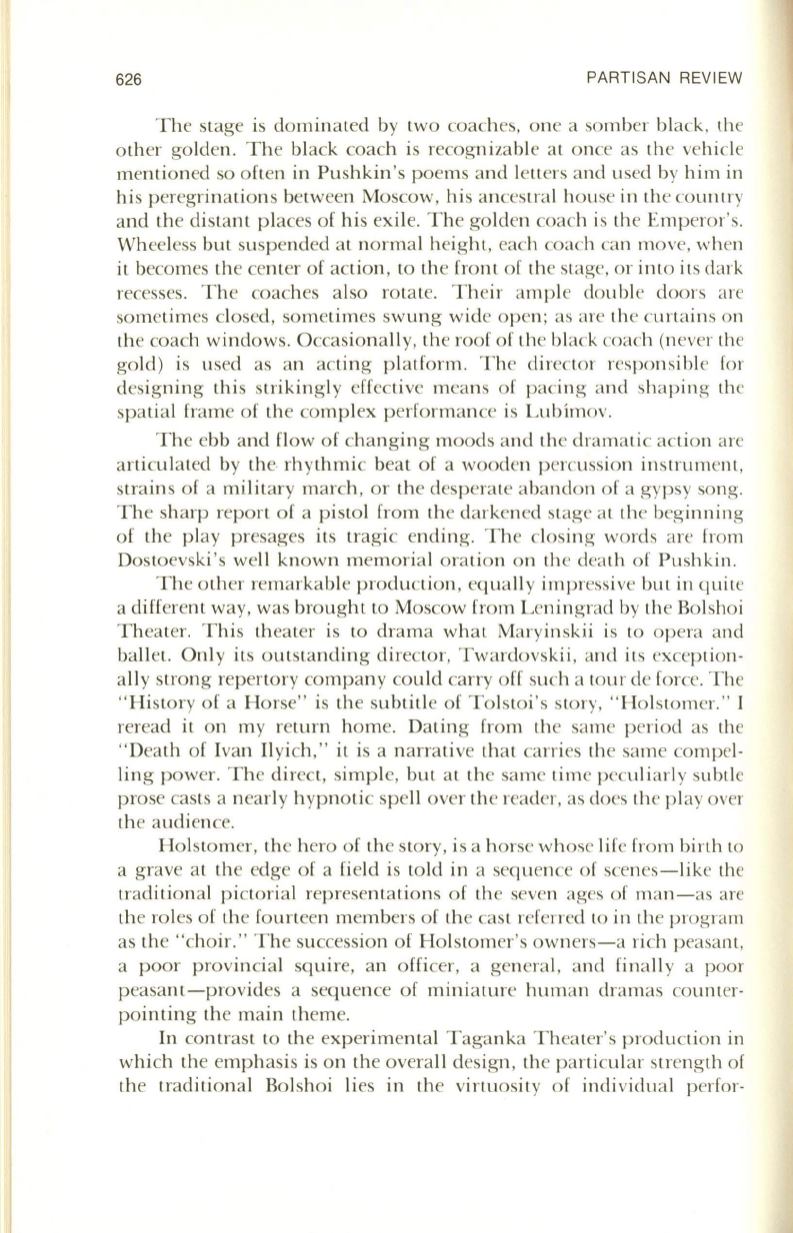
626
PARTISAN REVIEW
T he stage is domina ted by two coaches, one a somber black, the
o ther golden . T he black coach is recogni zabl e a t once as the vehicle
mentio ned so o ften in Pushkin 's poems and letters and used by him in
hi s peregrination s between Moscow, hi s ancestra l ho use in the country
and the distan t places of his exil e. The go lden coach is the Empero r's.
Wheeless but suspended a t no rma l height, each coach can move, when
it becomes the center of action , to the front of the stage, or into its dark
recesses. T h e coaches a lso rota te. Their ampl e doubl e doors are
sometimes closed , sometimes swun g wide o pen; as a re the curtain s on
the coach windows. Occasionall y, the roof o f the bl ack coach (never the
gold ) is used as an acting pla tfo rm . The direc to r respon sibl e for
designing thi s strikin gly effective means o f pacing and shaping the
spa ti al frame o f the compl ex performance is Lubimov.
The ebb and fl ow o f changing moods and the drama tic acti on are
a rticula ted by the· rh ythmic beat o f a wooden percuss ion instrument,
strain s of a military march , or the despera te abandon o f a gypsy song.
The sharp report o f a pi sto l from the darkened stage a t the beginning
o f the play presages its tragic ending. T he clos ing words a re from
Dostoevski 's well known memoria l ora tion on the dea th o f Push kin .
The other rema rkable production , equall y impress ive but in quite
a different way, was brought to Moscow from Leningrad by th e Bolshoi
Theater. This thea ter is to drama wha t Ma ryin skii is to opera and
ball et. Onl y its o utstanding directo r, Twa rdovskii , and its exception–
ally strong reperto ry compan y could ca rry
0 [[
such a tour de force. The
" Histo ry o f a Ho rse" is the subtitl e of T o lstoi's story, " Holstomer. " I
reread it on my return home. Da ting from th e same period as the
" Dea th of Ivan Il yich ," it is a narrati ve tha t ca rries the same compel–
lin g power. T he direct, simple, but a t the same time peculi arl y subtl e
prose casts a nearl y hypnoti c spell over the reader, as does the pl ay over
the audi ence.
Holstomer, th e hero of the story, is a horse whose life from birth to
a grave at the edge of a fi eld is told in a sequence o f scenes -like the
traditi onal pictori al representations o f the seven ages of man-as are
the rol es o f the fourteen members of the cas t referred to in the p rogram
as the "choir." The succession of Ho lstomer's own ers- a rich peasant,
a poor p rovincial squire, an o ffi cer, a general, and fin a ll y a poor
peasant-provides a sequence of mini a ture human dramas counter–
pointing the main theme.
In contrast to the experimental T aganka T hea ter's p roduction in
which the emphasis is on the overa ll des ign , the parti cu lar strength of
the traditi onal Bo lshoi li es in the virtuos ity o f indi vidual perfor-


